Before I start this review, I must once again thank @Toymany-kenc and all our friends at Toymany for the donation of these review samples for the Blog. I had a keen interest in purchasing this set, so I was very happy to be able to get one for review!
The domestic rabbit is descended from the European rabbit (Oryctolagus cuniculus). Rabbits are believed to have been first domesticated by Ancient Romans for both food and fur. They have played a prominent role throughout human history and today there are over 300 breeds in 70 countries around the world. The first domestic rabbits were brought to the United States in the late 1800s. In some places, feral rabbits have become an ecological disaster, most notably in places like Australia, New Zealand, and Chile, where control measures are underway. Today rabbits are still bred for fur, wool, and meat, but also as pets and companion animals, show animals, medical laboratory testing, and cosmetics testing, the last of which is thankfully on the decline due to the efforts of animal rights activists. Today we will be looking at a set of no less than 11 domestic rabbit breeds by Toymany! And as an added bonus, the set also includes a species of wild hare that, to the best of my knowledge, is the first representative of that species in toy form (more on that later in the review). This isn’t Toymany’s first set of rabbits. In their early days (which wasn’t too long ago), they produced a set of ten rabbits and hares. Most of those figures appear to be based on existing models by other brands (I am not up on most rabbit figures, but among them I see some were influenced by Safari Ltd. and Schleich). However, as Toymany continues to grow, they are now sculpting almost entirely (if not entirely) new, original models. Today’s set of 12 are all new and original Toymany sculpts! They are made of a hard, high-quality plastic and are extremely detailed in their sculpts. They are all painted with non-gloss paint and each has a different posture to add variety for display. The figures will be presented in no particular order, other than for saving the new species for last. For the domestic breeds, I will include a brief discussion on the origins of the breed, as well as what it was originally bred for and what it is used for today. I include measurements and tried to calculate scale, the latter of which was a challenge sometimes since rabbit breeds tend to be measured by weight rather than length. At times I found using ear length as a metric the most helpful. I will also mention other representatives of the breeds as toys or figures (although surprisingly, most toy rabbits are not marketed at the breed level).
Note: This is just an overview of the entire collection, and doesn’t preclude others from doing afull review of individual figures on the Blog (I might do a deep dive into one each year around Easter…)!
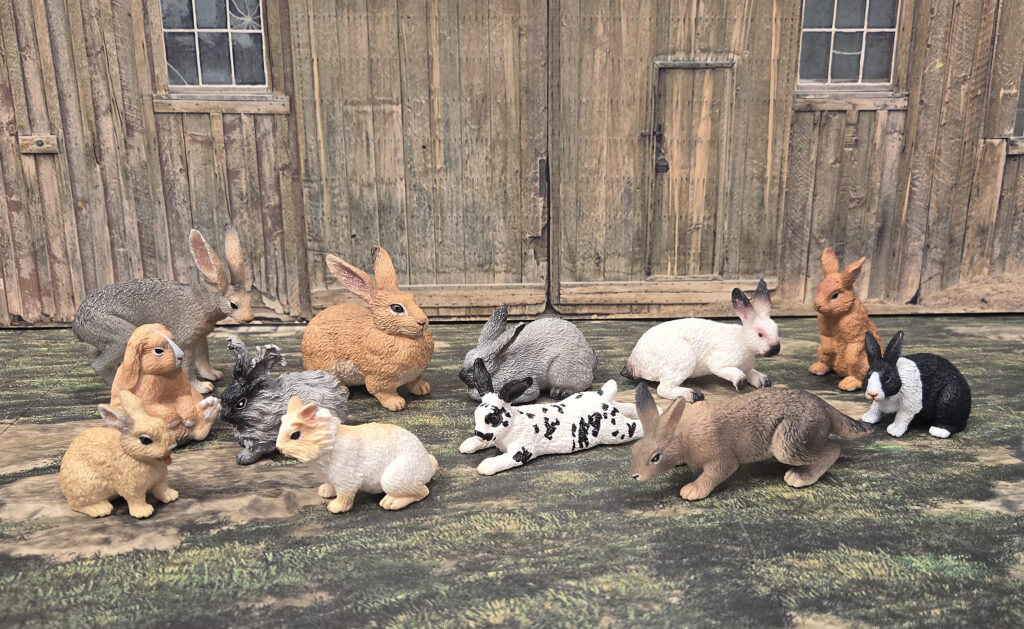
Angora
Angora represents a group of rabbit breeds that are bred for their fur, which is the source of Angora wool. The Angora is believed to have first been bred in Turkey (Ankara was historically known as Angora), and today is bred nearly worldwide. There are 11 distinct breeds of Angora; the one featured by Toymany today appears to be based on the German Angora in Black. It could also represent a Giant Angora, but the only acceptable color for the Giant according to the American Rabbit Breeders Association (ABRA) is Ruby-eyed White (albino). I found an image online that the Toymany figure is based on (Kenc was nice enough to share with me the pics the figures were based on) and it doesn’t specify the exact breed. The figure is 4.0 cm long. Using ear length as a metric (n=1.5 cm), the scale comes to approximately 1:7.3-1:9.3. Papo also produced an Angora.

Dutch
The Dutch rabbit, which also goes by the names Hollander or Brabender, was, despite those common names, originally from England and not the Netherlands. The Dutch was originally bred for meat but today it is one of the most popular pet breeds and is bred nearly worldwide. They are calm, affectionate, and easy to train. They come in a wide variety of colors, and this version by Toymany is the classic black. The figure is 4.8 cm long. Using either shoulder height (n=2.3 cm) or ear length (n=1.2 cm) as a metric, the scale averages at 1:8-1:10. Furuta also produced a Black Dutch rabbit in the Chocoegg Animatales line.
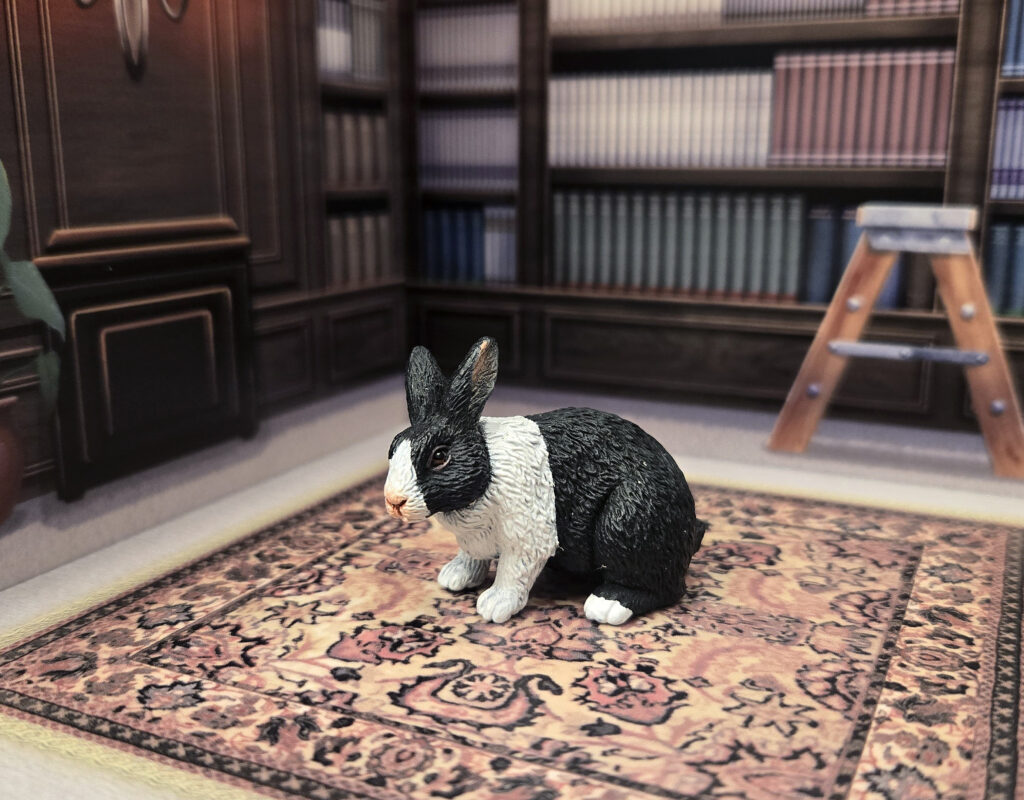
Lionhead
The Lionhead is a fairly new breed, having originated in France and Belgium. One theory is it was the result of a cross between a miniature Swiss Fox and a Netherland Dwarf, in an attempt to produce a long-coated dwarf rabbit. Another theory is that it was created by crossing a Jersey Wooly with a Netherland Dwarf. However, there is no genetic evidence yet to support either hypothesis. Regardless, the crossbreeding resulted in a genetic mutation that caused long wool to appear around the head (like a lion’s mane) and on the flanks. The Lionhead is a small breed and is mainly used as a pet or companion animal. The figure is 4.5 cm long. Using shoulder height as a metric (n=2.3 cm) scale comes to approximately 1:5.5-1:7.2. Schleich also produced this breed in 2024.

Netherland Dwarf
Unlike the Dutch rabbit (above), the Netherland Dwarf actually originated in the Netherlands! The breed is believed to have been developed in the early 20th century by mixing small Polish rabbits with small wild rabbits. It was originally bred to be a pet and today continues to be a very popular breed worldwide, and has served as genetic stock for other small breeds. The Netherland Dwarf comes in a large variety of colors; hard to say which this figure represents but it could be any one of several including Lynx, Orange, Fawn, among others. The figure is 3.5 cm long. Using ear length as a metric (n=0.9 cm), scale comes to approximately 1:5.6-1:7.1. This breed has also been produced by Furuta (Chocoegg Animatales) and Kaiyodo (Choco Q Animatales).

Californian
The Californian, as its name suggests, was first bred in the early 1920s in California, USA. The breed was created by first crossing standard Chinchilla rabbits with white Himalayans and then crossing that hybrid with New Zealand whites to increase its size. It was originally bred for meat and today is also bred for its fur and is becoming increasingly popular as a pet/companion animal. This figure is painted as the traditional white with dark points, the only color recognized by the ARBA (the British Rabbit Council, or BRC, recognizes three additional colors). The Californian is a large breed. This representative of it by Toymany measures 5.5 cm across its widest points. The body length comes to approximately 6.0 cm for a scale of 1:5.1-1:6.2. I am personally unaware of any other figures of this breed.
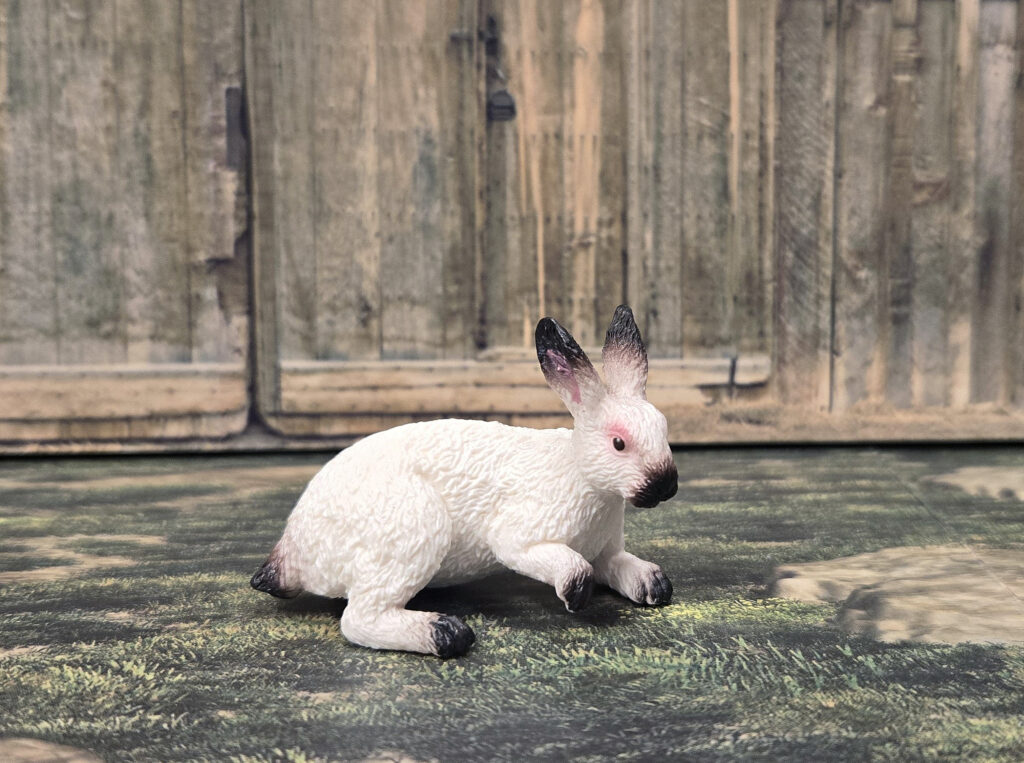
French Lop
The French Lop originated in the 1850s in France from the selective breeding of the English Lop with the Flemish Giant. The result is the largest of the lop-type breeds. It was originally bred for meat. In the early 1900s, as lops gained popularity, they were imported to other countries, and the French Lop made its way to America in the 1970s. Today, the French Lop is popular as a pet, but it requires space and does not do well caged. It is not a recommended breed for beginners, but can often coexist with children, dogs, and cats. The figure sits about 4.0 cm tall. Using ear length as a metric (n=1.7 cm) scale comes to approximately 1:7.5-1:12. Lop-style rabbits are not uncommon as toys and Furuta and Schleich have specifically made French Lops.
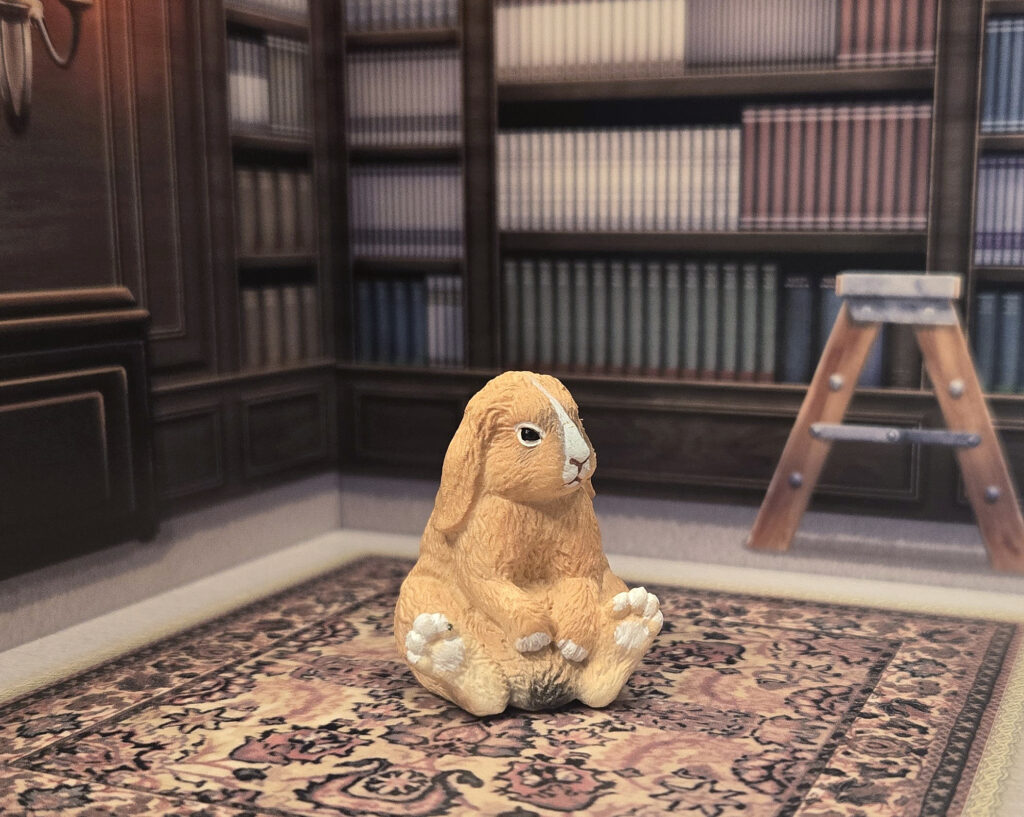
Belgian Hare
Despite its name, the Belgian Hare is a true domestic rabbit, created in 18th century Belgium by crossing early domestic rabbits with wild European rabbit. While it was originally bred for meat, today it is considered a ‘fancy’ breed used primarily for showing and it selectively bred to resemble wild European hare (Lepus europaeus). The Belgian Hare is responsible for launching the domestic rabbit industry in the United States. It is a large, long but slender, breed known for its wiry frame and powerful hind legs. It’s hard to tell what color variety this Toymany figure is based on. I presume a tan, but the underside is probably too pale for a winning animal in show! Total figure length is 8.5 cm. Using ear length as a metric (n=1.5 cm), scale comes to approximately 1:8.5 for a ‘typical’ show rabbit. To my knowledge, this figure is unique for its breed.
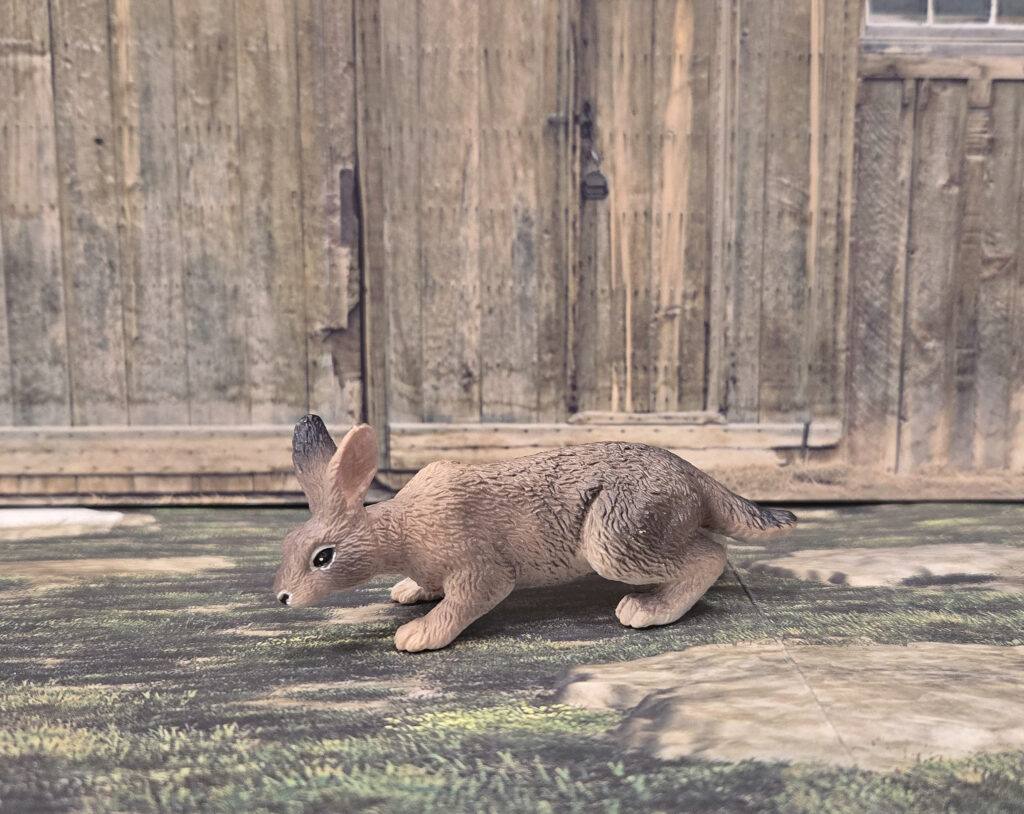
New Zealand
Despite its name, the New Zealand originated in California, USA, possibly from stock originally from New Zealand. It is a mix of breeds, including, but not limited to, Belgian Hares and Flemish Giants. Like many other rabbits, they were originally bred for meat. The original color is red, as shown here, but can also come in white, black, blue, and broken. The white form became popular for its coat, as it was easy to dye different colors. The New Zealand was also a popular breed for both medical and cosmetics laboratory testing due to their docility and good health. The figure stands about 5.0 cm tall. Using ear length as a metric (n=1.2 cm) scale comes to approximately 1:9.4-1:11.6. To my knowledge, this figure is unique for its breed.
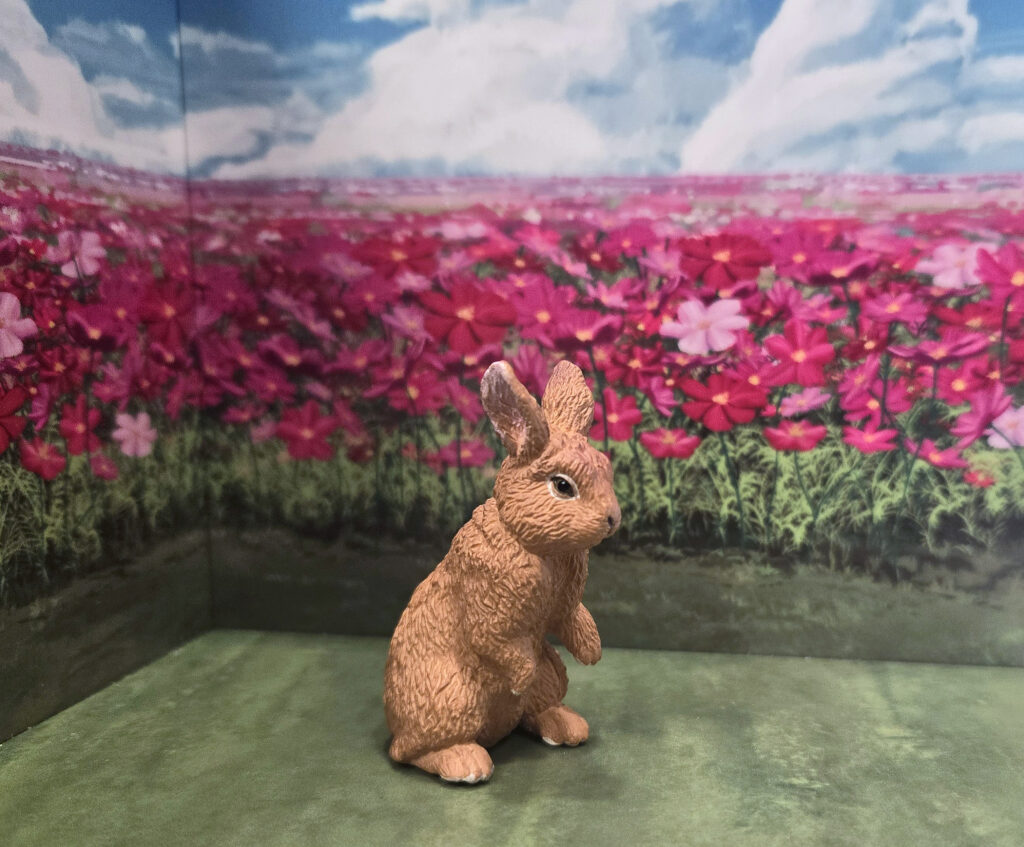
Argenté
The Argenté is one of the oldest breeds of French show rabbits. It comes in six varieties, and this Toymany figure was based on Champagne d’Argent. The origin of the breed is unknown, but may have been present in France by the mid 1600s. It was originally bred for both meat and its silvery pelt. I had a hard time finding metrics for this breed. Using body length as a metric (~5.5 cm), scale comes to approximately 1:6, but this should be taken with caution. To my knowledge, this figure is unique for its breed.
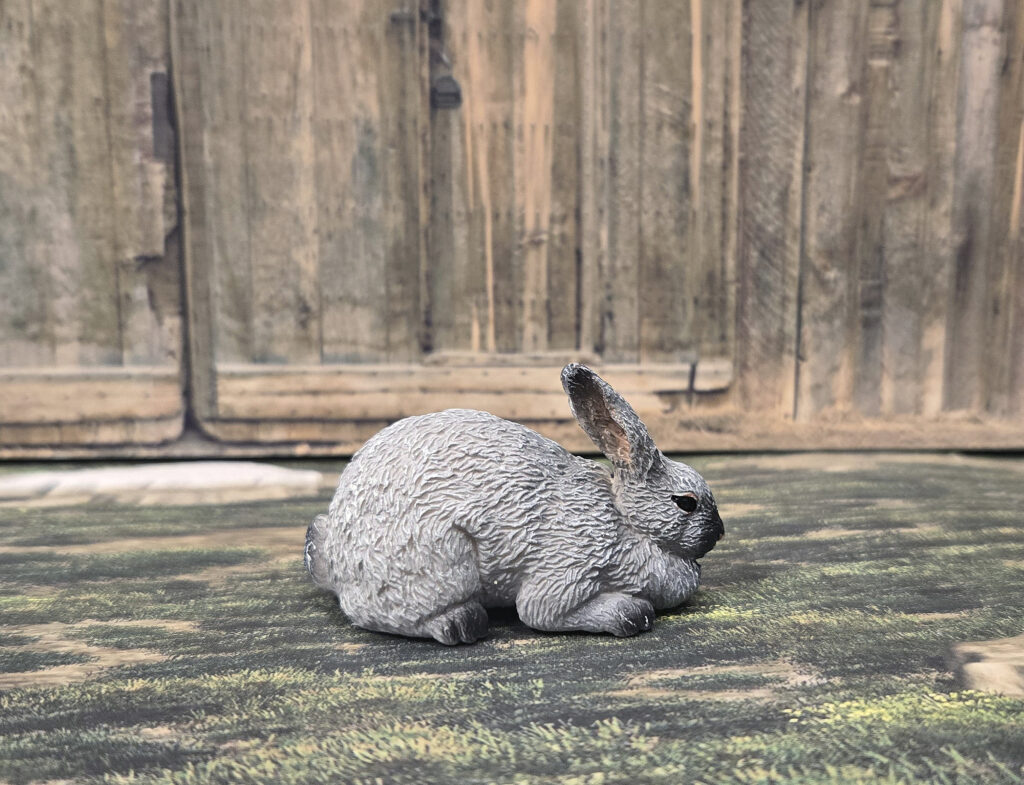
Flemish Giant
The Flemish Giant is, as its name suggests, an enormous breed of rabbit. In fact, it’s the largest breed of domestic rabbit in the world! It is believed to have originated in the Flanders region of Belgium as early as the 16th century. It is a mixture of several breeds and itself has been the stock of many popular breeds today including two we have already seen in this post, the French Lop and Belgian Hare. While originally bred for meat and fur, they are popular today as show and pet animals, especially since they are docile and tolerate being handled. They can even be trained to use a litter box! Being the largest domestic breed, this figure is one of the largest, if not stockiest, toys in the set. It measures about 6.0 cm long and using ear length as a metric (n= 2.0 cm), scale comes to approximately 1:7.6-1:10.2. Kaiyodo also produced this breed for the Choco Q Animatales Pet Series.
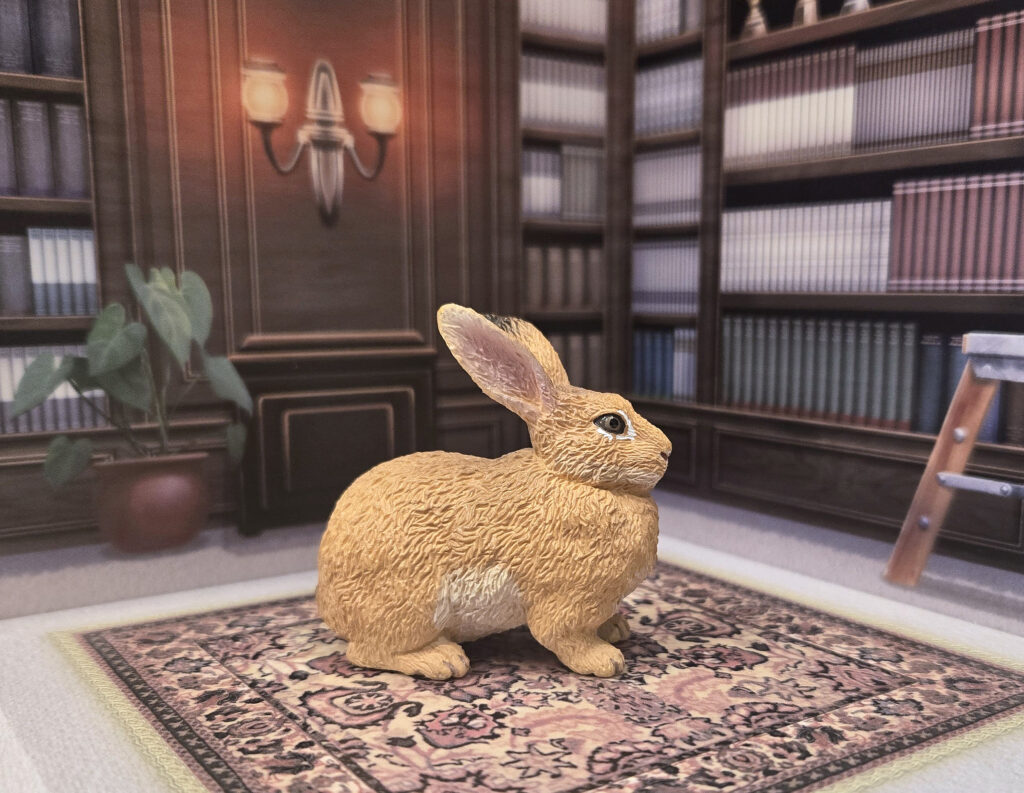
English Spot
The last domestic breed we’ll be looking at in this set is the English Spot which, as its name suggests, originated in England in the 19th century. The original stock is unknown but is believed to be Great Lorrainese (=Giant Papillon), English Butterfly, and/or Checkered Giant. It was imported to the US in 1910 and the American Spot Rabbit Club was established in 1924. They were originally bred to be show rabbits and today are popular as both show and pet animals. Raw figure length comes to 7.3 cm. This is another breed I had trouble finding metrics for but using ear length as a metric (n=1.2 cm), scale comes to approximately 1:10-1:11 (but this should be taken with caution). This breed has also been produced by Bullyland, Papo, and Schleich.

Antelope Jackrabbit
Last, but certainly not least, is the figure that I bet most collectors were most excited for, the antelope jackrabbit (Lepus alleni). Jackrabbits as a whole are fairly rare as toys, and to the best of my knowledge, this figure is unique for its species. The antelope jackrabbit occurs in western Mexico and extreme southeastern Arizona where it can be found in tropical and subtropical grasslands, desert grasslands, and Sonoran Desert. It feeds on available vegetation, which can include cacti, grasses, and the leaves of trees and shrubs. This figure by Toymany captures the svelte look of a jackrabbit. The body length comes to approximately 7.0 cm which would scale at 1:7.4-1:8.3. However, using ear length as a metric (n=2.4 cm), scale comes to approximately 1:5.8-1:7.1. Given the posture of the figure, ear length may be a more reliable metric. The figure is painted with a mostly grey wash with white accents around the ears, eyes, and mouth and grey-pink in the ears. One of the characteristics of the antelope jackrabbit is an orange wash on its throat and that, while faint, is present on this Toymany figure!
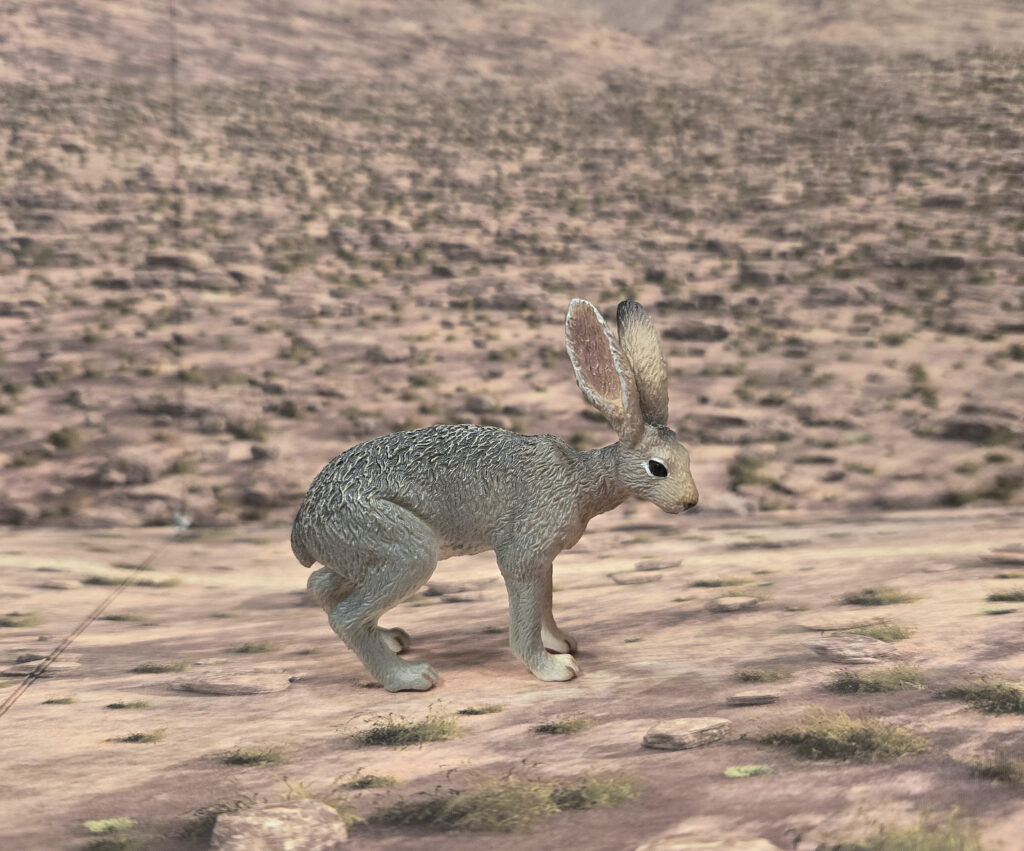
Overall this is a spectacular set and comes highly recommended to synoptic collectors, general animal collectors, and collectors of pets and farm animals. When I first started my synoptic collection, I struggled finding a domestic rabbit I liked (and have replaced them twice already). Had this set been available, any one of several of them would of satisfied my needs. Initially the only domestic animal I made an effort to get multiple breeds of was cattle. As I expand more and more into domestic breeds (e.g., dogs, cats, pigs, sheep, goats, and even horses), I have thought about rabbit breeds too. However, I was never able to pull the trigger and start investing in them. With this set by Toymany, one can get 11 domestic breeds at once, and very well made examples of them, too. Plus, let’s not forget the unique antelope jackrabbit! Luckily, no matter how many figures one wants from this collection, they are available both as a complete set and individually on Toymany’s website. Also, you can use the discount code TMAFBM10 when ordering directly from Toymany’s website and receive a 10% discount.
Disclaimer: links to Ebay and Amazon on the AnimalToyBlog are affiliate links, so we make a small commission if you use them. Thanks for supporting us!





Great set! I’m surprised by the quality of these. Thanks for sharing them here.
I’ve had pet rabbits throughout my life. I wouldn’t mind having a Dutch some day, I’ve always liked how they look.
yes, not sure how well my pics to the figures justice but in-hand they are spectacular and the level of detail and quality of paint is amazing.
BTW, if I had to pick one domestic rabbit from this set, the Dutch would have been my first choice! haha